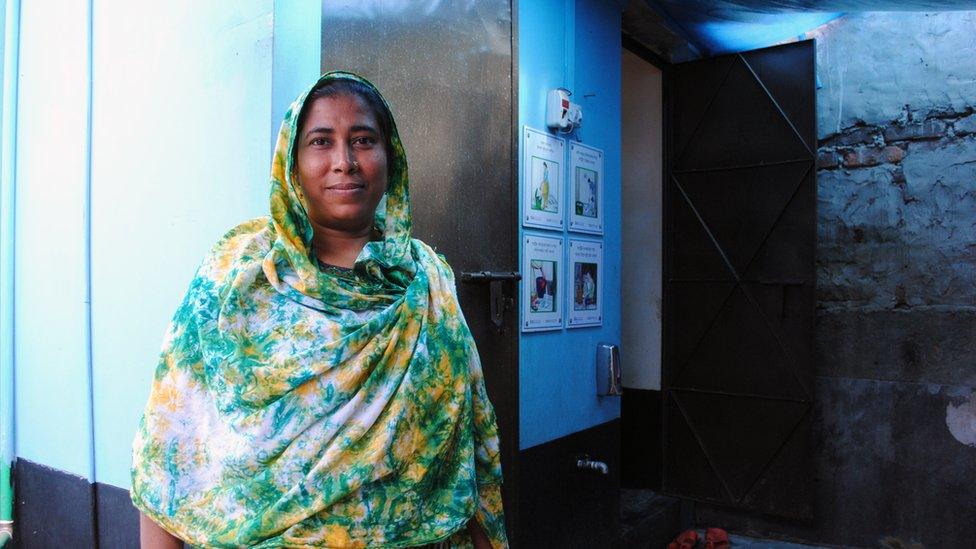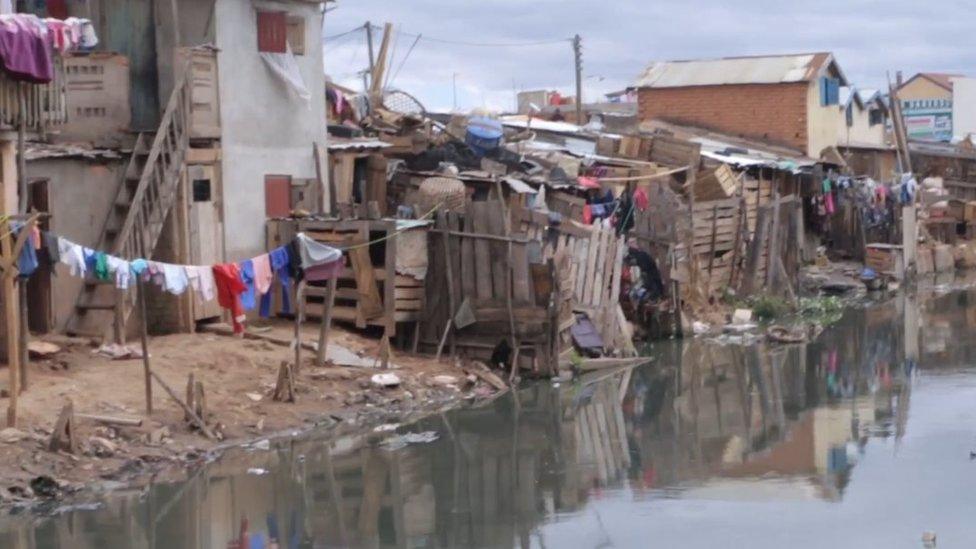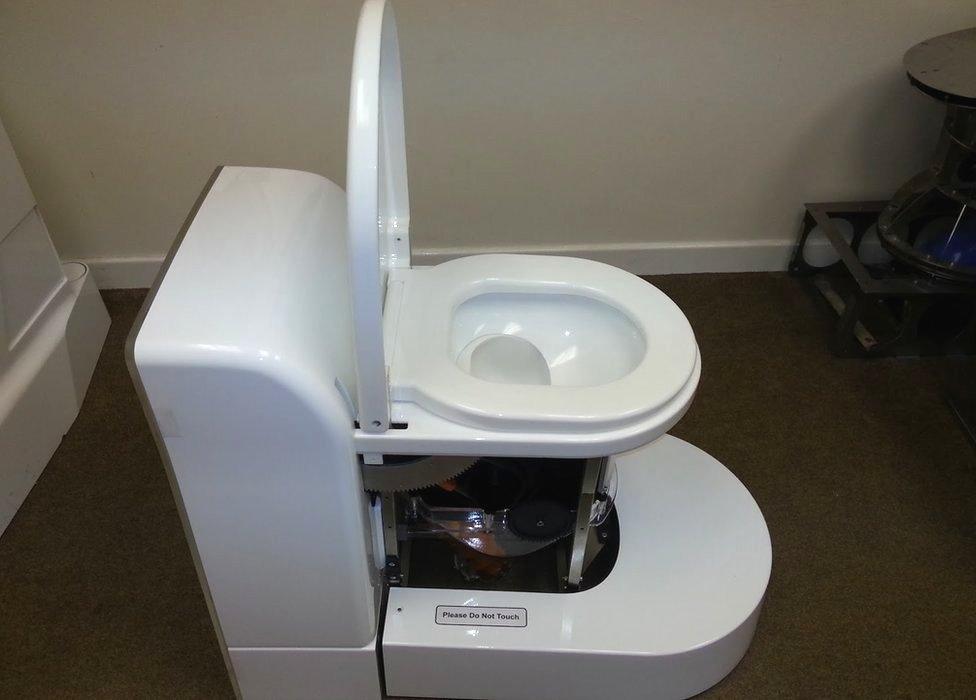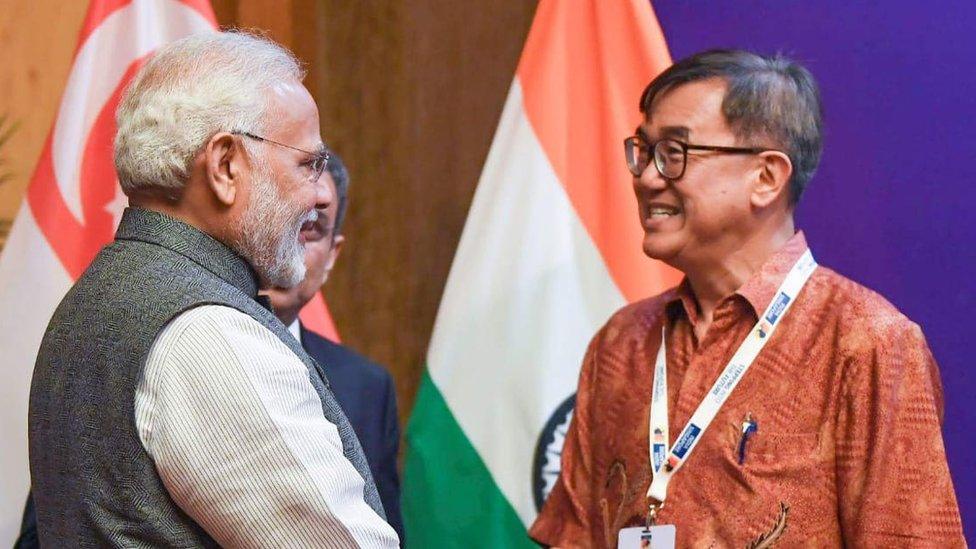Why do billions of people still lack basic sanitation?
- Published

Dhaka, Bangladesh: Community leader Nasima shows off her village's new community toilet
Hi-tech loos that use little or no water and can recycle waste products safely and sustainably promise to give billions of people around the world access to much-needed sanitation. So why do so many still lack this basic amenity?
About 2.3 billion people still lack basic toilets, according to the World Health Organization (WHO). And 4.5 billion don't have safely managed sanitation, with waste disposed in a way that won't contaminate drinking water.
Each year contaminated water kills half a million children under five through diarrhoeal diseases, the WHO says.
So many inventors, entrepreneurs and research institutions around the world have been working on hi-tech loos that can function without the need for expensive mains sewerage systems.

Millions of people live next to unsanitary open sewers with potentially fatal consequences
One approach is taking chloride from urine, turning it into chlorine with electricity, and using that as a disinfectant, says Dr Brian Hawkins, a research scientist in nanomaterials at Duke University, North Carolina.
Activated charcoal can remove organic material and nano-membranes replace the need for septic tanks, he says.
A solar-powered toilet using this approach, developed at Duke and nearby universities, is being tested at a cotton mill in Coimbatore, India and a township in South Africa.
Currently, it can handle about 15 users a day.
New membrane technology means toilets can "get clean water out of human waste, which is pretty cool", says Dr Alison Parker, a lecturer at Cranfield University in Bedford.
But power is needed to push waste through the membranes. So the challenge is making a self-contained loo that doesn't need external electricity.

Cranfield University's clever loo can produce clean water from human waste
Her lab's Nano Membrane Toilet works by "relying on the energy we can get from human waste, burning faeces, and the person lifting the lid and closing it again - so that's not a huge amount of energy to work with," she says.
But reverse electrodialysis, from putting faeces components on one side of the membrane and urine on the other, "gives us a little extra energy", she says, and is "just enough to give it the boost to do what we need".
Heating urine before it goes through the membrane to be closer to the vapour state makes it more efficient, too, says Dr Parker.


She says her lab's waterless flush toilet is "basically ready and could be commercialised straight away".
A challenge now is making them feasible for rural areas - the membranes need cleaning every three months, which is more easily achieved in cities.
Reducing costs
While there is lots of innovation going on, the key challenge is making sanitation affordable, says Jack Sim, World Toilet Day founder.
He remembers growing up in Singapore in the 1950s and 60s and having to use his village's communal outhouse. It was a "very traumatic" experience, he says, involving buckets and lots of green flies.
Moving to public housing with a flushable loo was "like a miracle", he recalls.

World Toilet Day founder Jack Sim (r) meets Indian Prime Minister Narendra Modi
He believes people on low incomes need to be convinced to "sacrifice something else and build a toilet first".
But many promising products are now stuck in the "valley of death", says Duke University's Dr Hawkins.
This is the space between developing a successful prototype and "getting to a locked-down product you can scale up, mass produce, and find a market share".
The aim is to get the operating expenses of clean toilets down to five cents (3.8p) per person per day, he says.
And Neil Jeffery, chief executive of Water & Sanitation for the Urban Poor, a non-profit organisation focusing on African and Indian cities, points out that it's "not just about the toilets - it's about how you collect waste safely, transport it, treat it, and how it's then used".
Most African cities only have 10-15% of households connected to mains sewerage, he says, with many urban settlements sharing pit latrines instead.
When these fill up, a lorry needs to take their contents to a treatment plant.

Crane Engineering's waste treatment trucks will be trialled in 2019
But this can be a costly two- or three-hour drive, says Mark Hassman, project manager for the Mobile Septage Treatment System at Crane Engineering in Wisconsin.
He says the amount of waste that trucks actually bring to treatment plants is "less than 5% [of the total] in some cities".
Instead, they dump it in ditches, mix it with rubbish and burn it, or "plop it in a ditch, and if it's rainy season, it goes downstream".
Mr Hassman has been leading a team designing trucks that can process 70-80% of the waste on site. So instead of emptying two pits, "they can now maybe do eight in one drive, and that hopefully reduces the cost and enables people to afford clean pit emptying," he says.
He says the trucks are "fairly close" to producing potable water.
The trucks will have trial runs in Africa in 2019, and his company is "looking to get these units out there" commercially in 2020.
The crucial requirement is to create a market that enables companies to make a profit from loos that are also affordable for poorer households, he says.

Special treatment trucks can turn human waste into clean water
Lack of sanitation also has an economic impact.
The Bill & Melinda Gates Foundation, which has been running its Reinvent the Toilet Challenge since 2011, says "more than $200bn (£155bn) is lost due to healthcare costs and decreased income and productivity" as a result of poor sanitation.
This is one of the reasons why Indian Prime Minister Narendra Modi has committed $20bn to build 111 million latrines by 2019 - "the biggest toilet building project in the history of mankind", says Mr Sim.
The goal of sanitation for all may still be "some years" away. "But I can see this problem being solved in the next decade," he says.
Not a day too soon for the billions still suffering.
Follow Technology of Business editor Matthew Wall on Twitter, external and Facebook, external